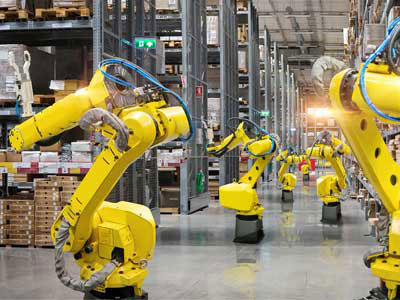Key Takeaway
The three most common types of industrial robots are Cartesian, SCARA, and Articulated robots.
Cartesian robots operate on three linear axes (X, Y, and Z). They move in straight lines, making them ideal for tasks like CNC machining and 3D printing.
SCARA robots have a unique design with two parallel rotary joints. They excel in pick-and-place tasks, assembly, and packaging.
Articulated robots have rotary joints, offering flexibility and a wide range of motion. They are perfect for welding, painting, and material handling.
These robots enhance productivity and precision in various industrial applications.
Articulated Robots
Articulated robots, with their multi-jointed arms resembling human limbs, are versatile workhorses in industrial settings. Picture a robot deftly assembling parts in an automotive plant or delicately handling items on a conveyor belt. Their ability to maneuver with precision across multiple axes makes them ideal for tasks requiring dexterity and range of motion. These robots excel in applications like welding, painting, and packaging, where precision and flexibility are paramount. Their adaptability and efficiency contribute significantly to enhancing productivity and maintaining high-quality standards in various industrial processes.

SCARA Robots
SCARA robots, short for Selective Compliance Assembly Robot Arms, are integral to modern manufacturing processes, especially in industries like electronics and packaging. These robots are renowned for their exceptional speed and accuracy, making them ideal for tasks requiring repetitive precision.
Overview of SCARA Robots
SCARA robots are characterized by their rigid, articulated arms capable of moving in the X, Y, and sometimes Z directions with high precision. This flexibility allows them to perform tasks such as picking and placing components on circuit boards or assembling small parts in rapid succession. Their design ensures minimal vibration and precise control, critical for maintaining production quality and efficiency.
In electronics manufacturing, SCARA robots excel at tasks like soldering, screw driving, and quality inspection. Their ability to handle these processes with millimeter-level precision ensures consistent product quality and reduces human error, thereby improving overall manufacturing efficiency.
Key Features and Applications
These robots are equipped with sophisticated end-of-arm tooling that enables them to adapt to various tasks seamlessly. Whether it’s placing delicate electronic components or handling small parts in assembly lines, SCARA robots offer unmatched reliability and speed. Their ability to operate continuously with minimal downtime further enhances productivity in high-volume production environments.
Delta Robots
Delta robots represent the pinnacle of high-speed automation, designed primarily for pick-and-place operations in industries requiring rapid throughput and precise handling. Their unique parallel-link arm design enables swift movements, making them indispensable in sectors like food packaging and pharmaceutical assembly.
Overview of Delta Robots
Delta robots derive their name from the triangular configuration of their arms, which are connected to a central platform. This design allows them to achieve remarkable speeds and dexterity while maintaining stability. Unlike traditional robotic arms, Delta robots excel in applications where speed and agility are paramount, such as sorting, packaging, and assembly of lightweight items.
In food packaging lines, Delta robots are used to pick and place items quickly and accurately into containers or onto conveyor belts. Their ability to handle fragile items without compromising speed ensures efficient production with minimal product damage.
Key Features and Applications
The lightweight construction of Delta robots, coupled with their parallel-link arm architecture, enables them to achieve accelerations and decelerations far beyond traditional robots. This capability translates into reduced cycle times and increased throughput, critical for meeting demanding production schedules.
Delta robots are also employed in pharmaceutical assembly lines for tasks like sorting pills, placing vials into trays, or assembling medical devices. Their precision and speed significantly contribute to improving operational efficiency and maintaining stringent quality standards in pharmaceutical manufacturing.
Usage Statistics and Trends
Articulated robots have revolutionized industrial automation with their unmatched flexibility and versatility. These robots, characterized by multiple joints resembling a human arm, are capable of mimicking complex movements required in various manufacturing processes. One of their primary advantages lies in their ability to maneuver and operate in confined spaces, optimizing floor space utilization in busy production environments.
Flexibility and Adaptability
Articulated robots excel in tasks that demand precision and dexterity, such as assembly, welding, and material handling. Their multi-axis design allows them to reach around obstacles and perform intricate operations with ease. This adaptability makes them indispensable across a wide range of industries, from automotive manufacturing to electronics assembly.
Precision and Efficiency
Moreover, articulated robots are known for their high precision and repeatability. They can execute tasks with accuracy down to fractions of a millimeter, ensuring consistent quality in production lines. This precision not only enhances product quality but also reduces waste and rework, contributing to overall cost savings for manufacturers.
Advantages of Each Type
SCARA (Selective Compliance Articulated Robot Arm) robots are valued for their speed, precision, and cost-effectiveness in specific industrial applications. Unlike articulated robots, SCARA robots operate within a horizontal plane, making them ideal for tasks that require fast and precise movements in a limited workspace.
Speed and Throughput
SCARA robots are designed for rapid motion, making them suitable for applications such as pick-and-place operations and packaging. Their ability to handle high-speed tasks with minimal cycle times enhances production efficiency, meeting the demands of industries where throughput is critical.
Cost-Effective Automation
In addition to speed, SCARA robots offer a cost-effective solution for automating repetitive tasks. Their simplified mechanical structure and fewer joints result in lower maintenance costs and reduced downtime, translating into higher operational efficiency and improved ROI for businesses investing in automation.
Conclusion
As you embark on your journey in industrial automation, understanding these common types of robots equips you with foundational knowledge essential for navigating the dynamic landscape of modern manufacturing. Whether you’re optimizing production lines, enhancing quality control, or exploring new applications, harnessing the power of these robots promises to revolutionize how industries operate.
